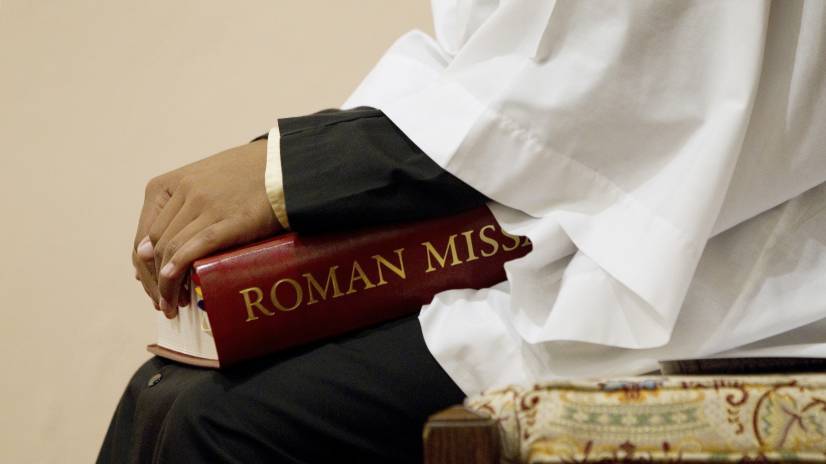Most of the information that I will use in deacon-structing the Mass comes from the text of a video we made in partnership with the National Liturgy Office of the Canadian Conference of Catholic Bishops in 2011 to help explain the latest changes to the language of the English Roman Missal, titled THE CELEBRATION OF EUCHARIST for the Twenty-First Century. The project was headed by Fr. Bill Burke, and the text was written by Canadian liturgist Margaret Bick, to both of whom I owe a great deal of thanks for the vast knowledge they shared with me.
In my parish we have a program called “Run With It” (how that name came about is the subject of another post at another time) where we answer questions that our parishioners have. We will answer any questions, small or big. We’ve done sessions on the sex-ed curriculum and about praying habits. We’ve done sessions on Scripture (to answer dinosaur questions, among others) and also sessions on heaven, hell, and purgatory.
But the most well-attended session was a “Teaching Mass” we did.
People want to know about the Mass.
Everything about the Mass has meaning, yet we are so used to it that often we go through the motions - sit, stand, kneel - without knowing what it is we are doing and why.
So it is my hope, over the next couple of weeks, to deacon-struct the Mass, bit by bit. I hope that this will help you enter into the mystery of the Mass more deeply.
The main document I am going to refer to is a document that you should all be familiar with:
The General Instruction of the Roman Missal (GIRM).* It states that “The celebration of Mass is the centre of the whole of Christian life.”
This means that we must understand what it is we are doing.
The liturgical changes that came with the Second Vatican Council had to do with a small change in understanding. The
General Instruction explains that our manner of celebration should lead to the
“conscious, active, and full participation of the faithful.” This means that our participation is required by the very nature of the celebration, and we, the Christian people, have a right and duty to this participation by virtue of our baptism.
The
GIRM makes it clear that much care must be taken so that at every moment of the Mass, this conscious, active, and full participation of everyone present is effectively fostered. I don’t have to tell you that most of the time we are not participating consciously, actively, or fully (sometimes we are not even conscious!), but I hope that after you read these reflections, your Mass experience will be much improved.
Let me say, before we get going, that it is not the responsibility of the celebrating priest or the choir to make sure that your experience is one of full, conscious, and active participation. That is your responsibility!
So… let’s begin!
The Structure of the Mass
For those not really paying attention, the celebration of the Eucharist might appear as a random collection of prayers and pious actions. But the Mass has a shape and flow. It consists of two major parts: the
Liturgy of the Word and the
Liturgy of the Eucharist. But these are not two separate parts; they are closely related. The
General Instruction says: “In the Mass is spread the table both of God’s Word and of the Body of Christ, and from it the faithful are instructed and refreshed.”
In addition to these two major parts, there are also Introductory Rites and Concluding Rites that make our transition to and from home a little easier.
Introductory Rites
The Introductory Rites are designed to help us
gather together. They should also help us set aside the busy-ness of our lives. They include everything that is done before the first Scripture reading: the entrance, the greeting, the penitential rite, the Gloria, and the opening prayer (also called the Collect).
I should say that, even before the formal beginning of the Mass, we need to open ourselves to the presence of Christ already among us. As we arrive, we cross ourselves with holy water that reminds us of our Baptism, and we
greet each other (note that greeting each other actually helps us enter into the spirit of what we are about to celebrate). We should then take our place and take a few moments to prepare ourselves for the celebration that is to come.
Come back next week and we’ll take apart the
first moments of the Introductory Rites.
-
*The other great document to look at is Vatican II's Constitution on Sacred Liturgy: Sacrosanctum Concilium.
You may be interested in watching these four videos with Fr. Bill Burke that explain the Mass in light of the changes that were made to the language of the Liturgy in English in 2011 and are still relevant.
Beyond Words part 1: The Significance of Eucharist in My Life
Beyond Words part 2: It's About Mystery, not rubrics
Beyond Words part 3: The GIRM - A document of tradition and continuity
Beyond Words part 4: The Theological emphases of the 2002 GIRM

Every week, Deacon Pedro takes a particular topic apart, not so much to explore or explain the subject to its fullness, but rather to provide insights that will deepen our understanding of the subject. And don’t worry, at the end of the day he always puts the pieces back together. There are no limits to deaconstructing: Write to him and ask any questions about the faith or Church teaching:
[email protected]
 Every week, Deacon Pedro takes a particular topic apart, not so much to explore or explain the subject to its fullness, but rather to provide insights that will deepen our understanding of the subject. And don’t worry, at the end of the day he always puts the pieces back together. There are no limits to deaconstructing: Write to him and ask any questions about the faith or Church teaching: [email protected]
Every week, Deacon Pedro takes a particular topic apart, not so much to explore or explain the subject to its fullness, but rather to provide insights that will deepen our understanding of the subject. And don’t worry, at the end of the day he always puts the pieces back together. There are no limits to deaconstructing: Write to him and ask any questions about the faith or Church teaching: [email protected]